Honda used to be among the auto industry's most innovative companies. Its achievements included the first hybrid car offered in the U.S., the teardrop-shaped, two-seat 2000 Insight. But Honda's hybrids never sold nearly as well as Toyota's, with an especially poor showing by the 2005-2007 Accord Hybrid. In general Hondas became less clever and less interesting than they used to be. They remained thoroughly competent and dependable, but "surprise and delight" seemed to have fallen off the menu with the new century.
Lately, though, each redesigned Honda has been considerably better than its predecessor. Plus the company's ability and willingness to rethink the automobile seems to be returning, and with it a second attempt at an Accord Hybrid. Could the new-for-2014 car provide definitive evidence that the Honda we knew and loved is back? If and when gas starts costing more than soda again, could it even sell?
I drove a Ford Fusion Hybrid a couple of years ago, but had the Lincoln MKZ for a week about the same time I had the Accord. My impressions of the Lincoln inform this review.
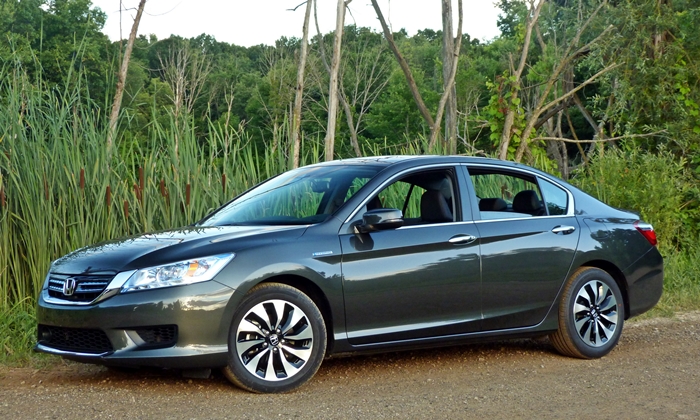
Handsome, perhaps, but not striking. Hybrid has unique wheels, badge on front fender. more Accord photos
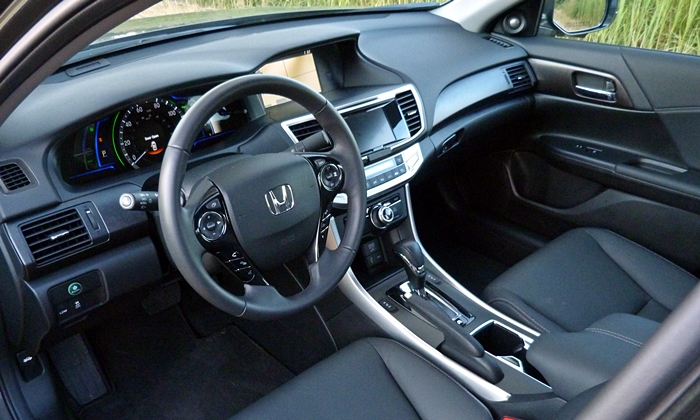
Restrained interior design can be a plus or a minus depending on personal taste.
| |
Compared to the Fusion |
| Fuel economy |
 Better
Worse
Better
Worse
|
We start with the downfall of the first Honda Accord Hybrid: it failed to deliver the mpg people expected from a hybrid. EPA ratings of 24 mpg city, 32 mpg highway were well above the regular V6's 18/26, but not much better than the four-cylinder's 21/31. Genius wasn't needed to discover the root cause: Honda had paired a 16-horsepower electric motor with a 240-horsepower V6 (for a combined 253--the two didn't climax together). Quite simply, the electric motor was too small--it couldn't power the car on its own--and the 3.0-liter gasoline engine was too large (if able to deactivate three cylinders while cruising).
Honda hasn't made the same mistake again. The new Honda Accord Hybrid joins a far stronger, 166-horsepower electric motor with a 141-horsepower 2.0-liter four-cylinder gasoline engine for a combined 196 horsepower. For the latter, Honda modified its new, significantly more efficient "Earth Dreams" engine to run, like Ford's and Toyota's hybrids, on the Atkinson-cycle (the intake valves remain open for the first bit of the compression stroke).
Honda's big idea isn't with the motor or the engine, though, but in how they are connected to the front wheels. There's no conventional stepped automatic transmission this time around. Nor is the transmission a planetary gearset CVT, as in Ford and Toyota hybrids. Nor is it a belt-and-pulleys CVT, as in the Honda Civic Hybrid. Instead, the new transmission barely warrants the term. It's a one-speed.
You won't find a one-speed transmission in any car powered by a conventional engine because a single ratio would be either way too tall for performance at low speeds or way too short for efficiency at high speeds. A conventional engine is only powerful at high rpm but only efficient at low rpm. For acceptable performance and efficiency, a transmission must be able to shift gears to put the engine at whatever rpm is appropriate for the current task (accelerating or cruising).
In contrast, electric cars DO tend to have single-speed transmissions, as their motors deliver acceptable efficiency and power over a much wider range. Given that the new electric motor is strong enough to accelerate the Accord on its own, Honda lets it do this up to 43 mph. At that point the fixed transmission ratio is a good match for the gasoline engine, and a clutch engages to connect it to the wheels. (At lower speeds the engine only comes on as needed to charge the battery pack.) Brilliant in its simplicity, this single-speed design dramatically reduces internal friction and weight.
The payoff: the new Accord Hybrid is rated 50/45, vs. the Fusion Hybrid's 44/41, the Camry Hybrid's 40/38, and the regular Accord's 27/36. In suburban driving the trip computer reported averages from 38.5 to 54.8, and 43 overall for the week (tying the MKZ Hybrid). I found it fairly easy to crack 50, spectacular for a midsize sedan.
| Powertrain performance |
 Better
Worse
Better
Worse
|
Once upon a time, an efficient car was also a slow car. Though a number of fairly quick hybrids and the ultra-quick Tesla Model S should have put this perception to bed by now, it's not quite dead yet.
The Honda Accord Hybrid should help. Despite the loss of two cylinders and a liter of displacement, the new one is just as quick as the first one, with a time of 7.6 seconds in Car and Driver's 5-60 mph rolling start acceleration test (which is more representative of how strong a car feels in typical driving than the typical smoking-tire zero-to-60 test). It's also as quick as the Toyota Camry Hybrid, and considerably quicker than the Ford Fusion Hybrid and Hyundai Sonata Hybrid.
Put another way, the Honda Accord Hybrid is as quick as the great majority of drivers will ever need it to be.
The quality of acceleration is more of a concern than the quantity. Though the transmission has a fixed ratio, power delivery sounds and feels more like that of a CVT than that of the actual CVT in the regular Accord. This is mostly a matter of sound. With the engine disconnected from the wheels below 43 mph, its rpm at around-town speeds varies based on the need to recharge the battery, which isn't tightly coupled to what you're doing with your right foot.
Beyond this variation, the engine sounds less buzzy than that in the Camry Hybrid, but louder and less refined than that in the Fusion Hybrid. Plus, if you really get on it, you'll provoke some torque-induced wiggling in the steering.
So, while the Accord Hybrid can be quick when you need it to be, it's more pleasant when driven casually.
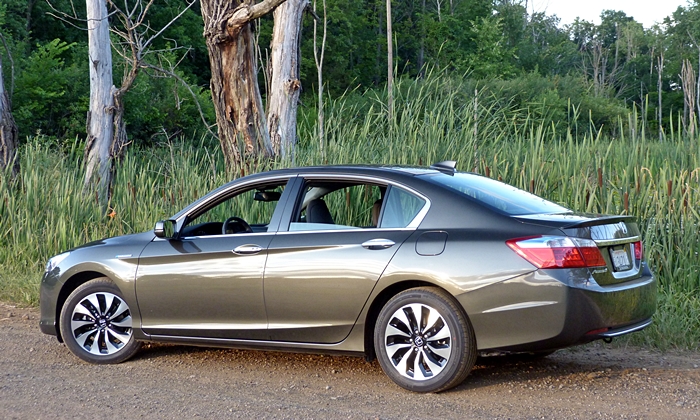
The Accord's best angle. Clear BMW influence in the kinked c-pillar and body side surfacing.
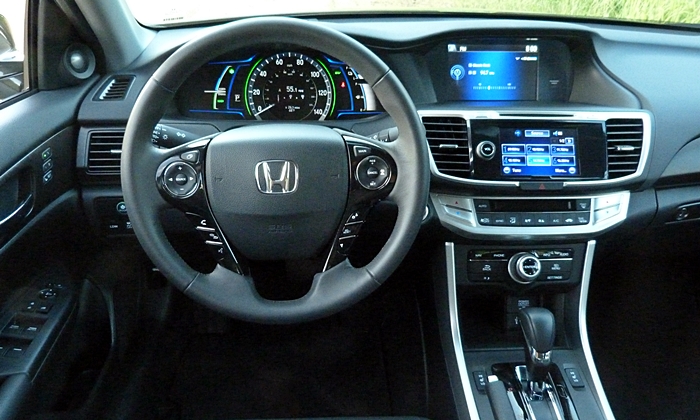
Reduced button count, but controls remain confusing. Knob, buttons at bottom control top display.
| Rear seat room & comfort |
 Better
Worse
Better
Worse
|
The Honda Accord's front seats are comfortable and properly supportive, but I find the Ford's even better.
The Accord's clear advantage is in the back seat, which is much roomier than the Ford's, and a match for any other in the segment with the exception of the limo-like Volkswagen Passat's.
| Handling |
 Better
Worse
Better
Worse
|
With well-controlled body motions and light yet precise steering, the Accord Hybrid easily out-handles the Camry Hybrid and Sonata Hybrid. The Fusion Hybrid poses more of a challenge. The Ford feels more taut and composed, while the Honda feels lighter, even delicate (in the positive, opposite of "heavy-handed" sense of the term). Preferences between the two chassis will depend more than a little on personal tastes. How firm do you like your steering and suspension?
This "why to buy" is tentative. While the regular Accord's reliability has been excellent, Honda has produced some decidedly unreliable hybrids in the past. So I'd like to see more time and miles before declaring the new Accord Hybrid glitch-free.
The new Fusion had a glitchy first year, including poor panel fits, but has improved since.
| |
Compared to the Fusion |
| Price or payments |
 Better
Worse
Better
Worse
|
The first Honda Accord Hybrid's second fatal flaw was a fairly high selling price, about $3,700 higher than that for the regular top-of-the-line Accord. The new one is based around a smaller engine and an incredibly simple single-speed transmission...but it remains about $3,500 more than the equivalent (now four-cylinder) non-hybrid Accord. For 2015, the base Accord Hybrid lists for $30,095, the EX-L for $32,845, and the Touring (tested) for $35,845.
Even before incentives, which tend to be higher on the Ford, a Fusion Hybrid undercuts these prices by $2,000 to $3,000, the higher number with the lower trim levels. Ditto with the Sonata Hybrid (which hasn't yet transitioned to the less attractive but better-handling redesigned model). The gap is about $1,000 narrower with the Camry Hybrid, but still significant.
If Honda's typically strong resale value applies to the new Accord Hybrid, some of this higher cost will be recouped when the car is traded or sold.
| Driving position & visibility |
 Better
Worse
Better
Worse
|
You sit well above the Honda Accord's instrument panel, and all of its windows are unfashionably large and set at a form-follows-function angle. In these respects, the car's driving position is excellent.
But the positioning of the freakishly over-sized speedometer (why?), steering wheel, and door-mounted armrest forced me to choose between seeing the top of the instruments and using the armrest. This is still better than in the Accord coupe, where a hard plastic door pull is located where my left elbow wanted to be.
The Fusion isn't as easy to see out of, but its instruments weren't clipped when I positioned the steering wheel for optimal comfort.
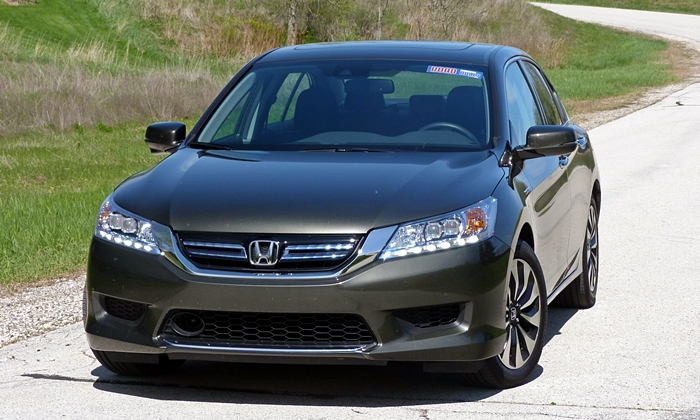
Accord Hybrids have blue-tinted grille and headlights (all LED in the case of the Touring).
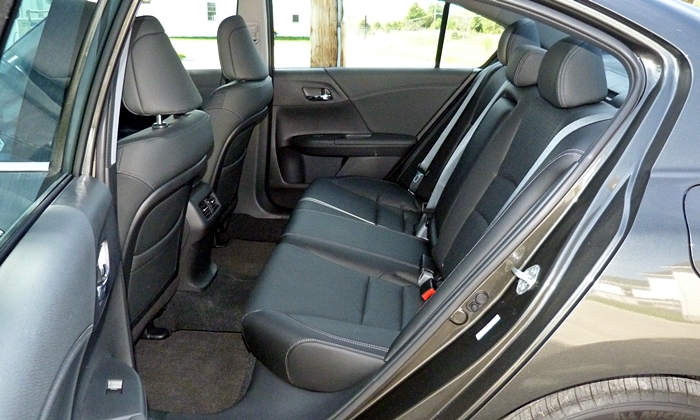
Very roomy rear seat.
| Controls and instruments |
 Better
Worse
Better
Worse
|
Other strengths of the driving position include easy-to-reach controls. Unfortunately, the control layout, with a touchscreen and HVAC controls interposed between a non-touch display and the knobs and buttons that control it, can confound unfamiliar drivers. Also, it's possible to display the same information in two, even three places.
The Ford's MyFord Touch infotainment interface has been widely criticized for issues with usability and responsiveness, even crashes. But the screen for it is larger and closer in the Fusion than in most other Fords. The Fusion Hybrid's instrumentation offers far more customization options than the Accord Hybrid's, and provides more detailed driving style feedback.
| Cargo capacity |
 Better
Worse
Better
Worse
|
The Honda Accord Hybrid's battery pack robs the trunk of three cubic feet. The remaining, practically shaped 12.3 cubes should prove sufficient nearly all the time. But if you need to carry objects too long to fit in the trunk, the rear seat cannot be folded to expand it. It can in the Fusion Hybrid (which has a similarly sized trunk). The non-expandable trunk in the Camry Hybrid is a foot larger than the other two--so same ballpark.
The Honda is also available as a plug-in hybrid, with a battery pack large enough to propel it about a dozen miles with the engine off. The Accord Plug-in Hybrid has two big weaknesses: a sticker price over $40,000 and an 8.6 cubic-foot trunk. Perhaps because the regular hybrid makes much more sense, the 2014 plug-in was only offered in California and New York--and the 2015 has yet to appear.
| |
Compared to the Fusion |
| Exterior styling |
 Better
Worse
Better
Worse
|
Some generations of the Honda Accord I enjoyed looking at: the third generation with its pop-up headlights, the fifth generation with its strong shoulders and somewhat sporty c-pillars. Maybe also the BMW-inspired pre-refresh second generation. But those have been exceptions rather than the rule. Most Accords have been forgettably (if tastefully) styled, and the latest (despite the return of some Bavarian details) is among these.
Even with its 2015 update, the Camry won't turn heads any more than the Accord. But the Fusion will.
| Interior styling |
 Better
Worse
Better
Worse
|
The Accord's interior is similarly tasteful and bereft of drama. But drama tends to be less desirable inside a car, so this could be a reason to buy one for many people. I doubt many Accord buyers wish its interior was more like that of the Civic, with its starship instrument panel.
The Accord's interior materials are pretty good. Nothing seems cheap. But the Ford's even more cleanly styled interior looks and feels more upscale.
| Ride smoothness |
 Better
Worse
Better
Worse
|
The Accord Hybrid rides very steadily when hustled across patchy pavement. Amplitude reactive dampers, which are unique to the hybrid and automatically firm up to rein in large suspension motions, might deserve some of the credit. But in casual driving the sedan's ride sometimes feels jiggly, with the occasional sharp kick. The Fusion's suspension feels firmer and tighter, but it better suppresses such jiggles and kicks.
| Quietness |
 Better
Worse
Better
Worse
|
Noise levels compare similarly. The current Accord is quieter than its predecessors. But the Fusion seems even quieter, and the quality of the wind, road, and engine noise that does intrude lends its interior a more luxurious ambiance. After all, the same basic car is offered as a Lincoln.
| Feature availability |
 Better
Worse
Better
Worse
|
The Touring trim level includes two features that weren't available until recently on any mainstream midsize sedan: full-LED headlights and adaptive cruise control. The Fusion is available with the latter, but not the high-tech lights. On the other hand, you can't get the Fusion's blind spot and lane departure warning systems in the Accord. Honda's engineers took a different tack, fitting many of their cars, including the Accord Hybrid, with a passenger-side rearview camera that can be summoned at any speed. Other auto writers haven't cared for this solution, but I personally prefer being able to see what's off my rear quarter to a warning light.
These are all just details, though. The big thing you can only get in the Honda is its innovative transmission.
Running through the Honda Accord Hybrid's strengths and weaknesses one at a time, it's possible to lose sight of the all-around excellence of the car. Sure, it's nothing special to look it, but (aside from the control layout) exudes thoughtful design and performs typical daily tasks very well.
To the regular Accord's strengths the hybrid adds outstanding fuel economy. The single ratio transmission, with a powerful electric motor entirely responsible for driving the wheels at around-town speeds, is utterly brilliant. It's the sort of "outside the box" (the cliche is warranted here) innovation we used to see much more frequently from Honda. Hopefully it's a sign of more to come.
The Accord Hybrid isn't as stylish and upscale as the Fusion Hybrid, but it is quicker and roomier. And it will probably prove more reliable, though it's too soon to call this part of the contest. In the final analysis, if anything restrains sales of the new Accord Hybrid it will be the car's price--and sub-$3 gasoline.

New electric motor is ten times as powerful. Around town, gas engine only charges the battery pack.
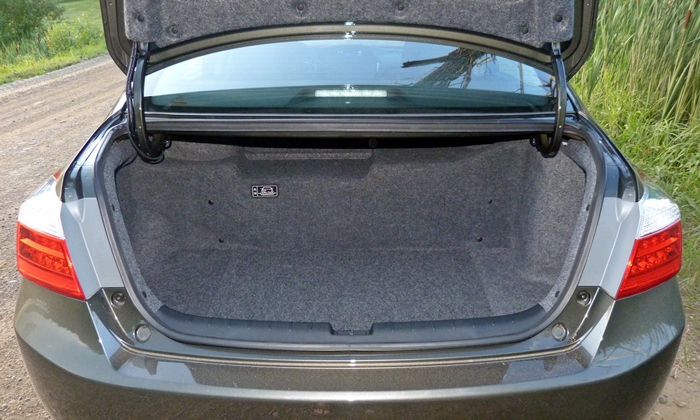
Usefully large trunk despite battery pack, but the rear seat cannot fold to expand it.
See more 2014 Honda Accord photos
Honda provided an insured car for a week with a tank of fuel. Ford provided a fueled, insured car plus lunch at an event for invited media.











